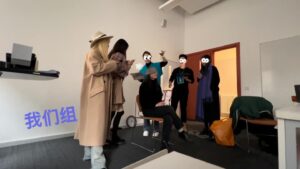Carlton Hill Trip – Perceptual Art Attempt
Perception is a fundamental theory in art psychology. In Chinese, perception is written as ‘感知‘, meaning feeling and perception, a term that encompasses both the more intuitive and figurative sensations and the more complex and abstract perceptions.

In an attempt to recreate the journey to Calton Hill using sensory experience and perceptual art, we experimented with four sensory modalities other than sight, including hearing, touch, taste and smell, placing the participants in an environment deprived of visual experience to narrate and convey the story using speech, sound and touch.

The sound of a car’s horn becomes a representative symbol of the road, and the listener is automatically transported to the scene when the sound of a car is heard.

The sound of the wind, the sound of pedestrians and the traffic on the road are complemented by a constant soundtrack: the wind. This is one of the features of the sensory art experience: the sense of flux.
I stopped on the way to Calton Hill and went into a supermarket to buy a packet of sour and spicy cornflakes, which I shared with all the members of our group later in the visit to Calton Hill, so the taste of the sour and spicy cornflakes and the memory of the Calton Hill scene were bound to each other for a long time to come – this is sensory memory. So whenever I travel somewhere I choose to take a bottle of perfume with me, so that when I smell it again I am reminded of the memory of having travelled because of the smell.

For the grass and gravel paths, we tried to record the sound of walking on different path materials. The grass sounded rustling and gentle and soft, while the gravel paths had a sharp sound of friction and squeezing, the stone paths were heavy and the muddy paths had a slightly sticky and watery sound. Because of the different sound effects the participant can be informed of the different sites and distances.

Leaves and dead branches and fine raindrops, as opposed to the 4D cinemas and VR experience pavilions, which are mostly represented by the gimmick of the live experience, real touch must be the most important aspect of the live experience, where the participants are guided through verbal descriptions when vision is deprived, bringing them into an unfamiliar touch that cannot be seen, where touch and language replace real vision when the specific shape of the object cannot be seen The participants are given an ambiguous experience.




Recent comments